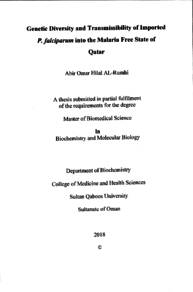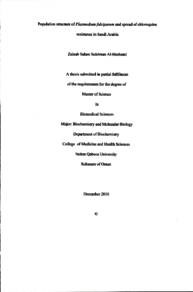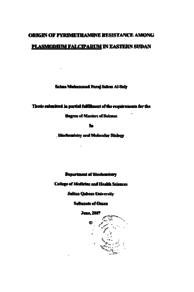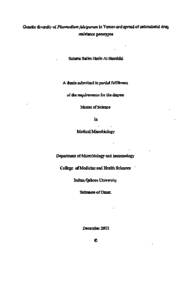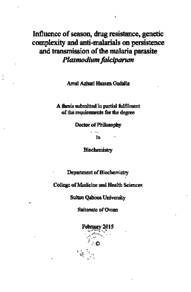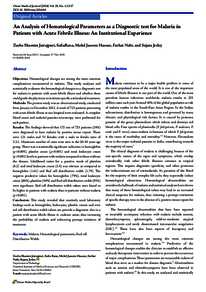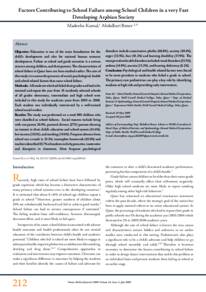وثيقة
Genetic diversity and transmissibility of imported p. falciparum into the malaria free state of Qatar
الناشر
Sultan Qaboos University
ميلادي
2018
اللغة
الأنجليزية
الملخص الإنجليزي
Background: Imported malaria represents a major threat to the prospect of elimination and eradications in areas where transmission has been interrupted. In the past two decades many countries in the Arabian Peninsula have successfully interrupted local transmission. However, this success is jeopardized by the massive influx of migrant workers from endemic areas. The present study examined the source of imported Plasmodium falciparum into Qatar and assessed its genetic diversity and ability to transmit if vector control relaxes.
Methods: P. falciparum isolates were collected from 94 imported cases reported to Hamad Medical Corporation, Qatar. Parasite density was estimated using qPCR of 18S rRNA. Early and late gametocyte stages were detected and quantified using qRT-PCR. Ten microsatellites representing seven chromosomes of P. falciparum were genotyped using PCR and fragment analysis. The genetic data was analyzed to assess genetic diversity and genetic relatedness of imported parasites in few foci, where transmission occurs, in the region.
Results: Ninety-Four P. falciparum isolates reported by migrants from Africa (n = 77), the Indian Subcontinent (n = 13) and unidentified origin (n = 4) were examined. The median parasitaemia among imported cases from the Indian Subcontinent (99571.8 parasites per ml blood) was 1.13 folds higher than that from Africa (88503.9 parasites /ml of blood). A large proportion of imported cases (50%, 27/54) carried mature gametocytes, indicative by presence of Pfs 25 transcripts and many (13%, 7/54) carried early gametocytes, indicative by presence of Pfpeg4 transcripts. However, many isolates (37%, 20/54) carried a mixture of early and late gametocytes transcripts (Pfpeg4) and (Pfs25).
A high degree of allelic diversity (expected heterozygosity) was observed among parasites from both continents. However, the number of effective alleles was higher among isolates originating from Africa compared to the Indian Subcontinent. A high multiplicity of infection and mild, but statistically significant linkage disequilibrium, was seen among P. falciparum populations from both regions. Low Fst estimate was seen between parasites in both sites and with Saudi Arabia and Yemen were local parasite transmission occur suggesting lack of geographical differentiation.
Conclusion: Imported P. falciparum into Qatar is genetically diverse, with no evidence of genetic isolation. The presence of transcripts of early and late gametocyte specific genes, signifies the ability of imported malaria parasites to transmit, when vector control measures relaxes in receptive areas. There is necessity to implement molecular surveillance to ensure higher efficiency measures to prevent reintroduction of malaria.
المجموعة
URL المصدر
الملخص العربي
تمثل الملاريا المستوردة تهديدا رئيسيا للقضاء على الملاريا واستئصالها في المناطق التي توقف فيها إنتقال المرض. في العقدين الماضيين نجحت بلدان كثيرة في شبه الجزيرة العربية في وقف الإنتقال المحلي للمرض. غير أن هذا النجاح يتعرض للخطر بسبب التدفق الواسع للعمالة المهاجرة من المناطق المستوطنة للمرض الملاريا. وقد تناولت الدراسة الحالية مصادر وجود طفيل بلاسمودیوم فالسيباروم أحد مسسبات الملاريا في قطر، وقدرت تنوعها الجيني وقدرة البعوض على نقل الطفيل في حال تراجع طرق مكافحة الناقل والطفيل.
شملت الدراسة 94 عينات بلاسمودیوم فالسيباروم من حالات مستوردة, تم الإبلاغ عنها في مؤسسة حمد الطبية في قطر. تم تقدير كثافة الطفيل باستخدام qPCR 18S rRNA .وتم الكشف وتحديد الكمية من الطور المبكر والمعدي من الطفيل بإستخدم qRT - PCR . عشرة مناطق وراثية (Microsatellites) مثلت 7 کروموسومات من بلاسمودیوم فالسيباروم حللت وراثيا بإستخدام تحليل الوحدات الوراثية (PCR and fragment analysis) وتم تحليل البيانات الوراثية لتقييم التنوع الجيني والإرتباط الوراثي للطفيليات المستوردة مع الطفيليات المتواجدة في بؤر قليلة في مناطق مختلقة ، حيث يحدث انتقال للمرض في تلك المناطق.
وقد تم فحص 94 من عينات بلاسمودیوم فالسيباروم مثلت مهاجرون من أفريقيا (عدد = 77) وشبه القارة الهندية )عدد = 13) وأصل مجهول الهوية (عدد = 4). وكان الوسيط للكثافة الطفيل (Median parasitaemia) بين الحالات المستوردة من شبه القارة الهندية أعلى ب 1.13 أضعاف من الحالات المستوردة من أفريقيا. نسبة كبيرة من الحالات المستوردة (50٪ ، 54 / 27 ) تحمل الطور المعدي للطفيل و(13٪ ، 7/54) الطور المبكر للطفيل ، بدلالة وجود الجين Pfs25. ومع ذلك، العديد من العينات (37٪ ، 20/54) أحتوت خليط من الجينات في الطور المبكر والمعدي للطفيل (Pfpeg4) و (Pfs25).
وقد لوحظ وجود درجة عالية من التنوع الجيني (Expected heterozygosity) بين الطفيليات من كلا القارتين، ومع ذلك، كان عدد الأليلات الفعالة أعلى بين العينات التي يعود أصلها إلى أفريقيا مقارنة بشبه القارة الهندية. وقد لوحظ عدد كبير من العدوى المتعددة بالإضافة الى وجود ترابط غير عشوائي (Linkage Disequilibrium) طفيف ولكن ذو دلالة إحصائية بين طفيل البلاسمودیم فالسيباروم من كلا القارتين. ولقد لوحظ وجود تقديرات منخفضة من التمايز الجيني (Fsr) بين الطفيليات من في كلا الموقعين ومع السعودية واليمن مما يشير إلى عدم وجود تمایز جغرافي.
طفيل البلاسمودیم فالسيباروم المستورد في قطر متنوع وراثيا ولا يوجد دليل على العزلة الجينية للطفيل بين القارتين. ووجود الجينات الخاصة بالطور المتقدم والطور المعدي من الطفيل تؤكد قدرة طفيل الملاريا المستورد على نقل المرض في المناطق الخالية من المرض, عندما تكون طرق مكافحة الناقل والطفيل غير فعالة في المناطق القابلة للعدوى. ولذلك هناك ضرورة قصوى لإستخدام التقنيات الجزيئية الحديثة من أجل ضمان تدابير أعلى كفاءة لمنع إعادة الإدخال والإصابة بالملاريا.
شملت الدراسة 94 عينات بلاسمودیوم فالسيباروم من حالات مستوردة, تم الإبلاغ عنها في مؤسسة حمد الطبية في قطر. تم تقدير كثافة الطفيل باستخدام qPCR 18S rRNA .وتم الكشف وتحديد الكمية من الطور المبكر والمعدي من الطفيل بإستخدم qRT - PCR . عشرة مناطق وراثية (Microsatellites) مثلت 7 کروموسومات من بلاسمودیوم فالسيباروم حللت وراثيا بإستخدام تحليل الوحدات الوراثية (PCR and fragment analysis) وتم تحليل البيانات الوراثية لتقييم التنوع الجيني والإرتباط الوراثي للطفيليات المستوردة مع الطفيليات المتواجدة في بؤر قليلة في مناطق مختلقة ، حيث يحدث انتقال للمرض في تلك المناطق.
وقد تم فحص 94 من عينات بلاسمودیوم فالسيباروم مثلت مهاجرون من أفريقيا (عدد = 77) وشبه القارة الهندية )عدد = 13) وأصل مجهول الهوية (عدد = 4). وكان الوسيط للكثافة الطفيل (Median parasitaemia) بين الحالات المستوردة من شبه القارة الهندية أعلى ب 1.13 أضعاف من الحالات المستوردة من أفريقيا. نسبة كبيرة من الحالات المستوردة (50٪ ، 54 / 27 ) تحمل الطور المعدي للطفيل و(13٪ ، 7/54) الطور المبكر للطفيل ، بدلالة وجود الجين Pfs25. ومع ذلك، العديد من العينات (37٪ ، 20/54) أحتوت خليط من الجينات في الطور المبكر والمعدي للطفيل (Pfpeg4) و (Pfs25).
وقد لوحظ وجود درجة عالية من التنوع الجيني (Expected heterozygosity) بين الطفيليات من كلا القارتين، ومع ذلك، كان عدد الأليلات الفعالة أعلى بين العينات التي يعود أصلها إلى أفريقيا مقارنة بشبه القارة الهندية. وقد لوحظ عدد كبير من العدوى المتعددة بالإضافة الى وجود ترابط غير عشوائي (Linkage Disequilibrium) طفيف ولكن ذو دلالة إحصائية بين طفيل البلاسمودیم فالسيباروم من كلا القارتين. ولقد لوحظ وجود تقديرات منخفضة من التمايز الجيني (Fsr) بين الطفيليات من في كلا الموقعين ومع السعودية واليمن مما يشير إلى عدم وجود تمایز جغرافي.
طفيل البلاسمودیم فالسيباروم المستورد في قطر متنوع وراثيا ولا يوجد دليل على العزلة الجينية للطفيل بين القارتين. ووجود الجينات الخاصة بالطور المتقدم والطور المعدي من الطفيل تؤكد قدرة طفيل الملاريا المستورد على نقل المرض في المناطق الخالية من المرض, عندما تكون طرق مكافحة الناقل والطفيل غير فعالة في المناطق القابلة للعدوى. ولذلك هناك ضرورة قصوى لإستخدام التقنيات الجزيئية الحديثة من أجل ضمان تدابير أعلى كفاءة لمنع إعادة الإدخال والإصابة بالملاريا.
قالب العنصر
الرسائل والأطروحات الجامعية

